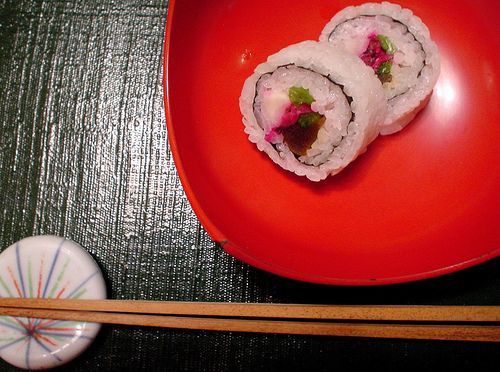Want To Stop Snacking So Much? Try Eating Off A Red Plate

Mindless snacking is a problem that, at some point or another, has afflicted even the best of us. Suddenly, “one more” chip or cookie turns into throwing the empty bag in the trash. While the indulgence often feels out of your control, a new study shows that portioning the snacks onto a red plate may help you stop snacking so much.
The study departs from sizable bodies of evidence that show fast-food restaurants use the color red so often in their logos because the color actually promotes appetite. Researchers from the University of Basel's Department of Social and Economic Psychology gave test subjects the option to snack on pretzels while they filled out questionnaires. Depending on the experimental condition, the pretzel plate was white, blue, or red. Overwhelmingly, the subjects who were offered pretzels on the red plate ate the fewest number of them.
The researchers also had participants drink out of red or blue cups as part of the experiment. Red cups were preferred over blue cups.
“In line with our hypothesis, participants drank less from a red labeled cup than from a blue labeled cup (Study 1), and ate less snack food from a red plate than from a blue or white plate (Study 2),” the team wrote. “The results suggest that red functions as a subtle stop signal that works outside of focused awareness and thereby reduces incidental food and drink intake.”
Much like the responses we’ve been conditioned to observe since childhood — yielding to stop signs, red lights, and, well, yield signs — the team’s findings suggest eating off a red plate induces the same compulsions. A separate 2011 study found that monkeys behaved more submissively when experimenters delivered food while wearing a red cap, while blue and green caps had no effect. The findings led Dartmouth researcher and neuroscientist Jerald D. Kralik to link the color red to evolutionary signs of danger, or “No.”
“The similarity of our results with those in humans suggests that avoiding red or acting submissively in its presence may stem from an inherited psychological predisposition,” he said in a press release. Given how social humans and monkeys both are, seeing redness in others’ skin or knowing which foods are safe to eat lets scientists “see that color may have a deeper and wider-ranging influence on us than we have previously thought.”
Conflicting data has less science behind it for why red induces appetite. Often, experts will point to the bevy of fast-food logos that employ red in some capacity: Burger King, McDonald’s, KFC, Tim Horton’s, Wendy’s, Domino’s Pizza, Chik-Fil-A, Pizza Hut, Sonic, Dairy Queen, Arby’s, In-N-Out, Carl’s Jr., Hardee’s — the list goes on. And the interpretations profess the same one-two punch. The color yellow signals quickness while red makes you hungry — the perfect combination for restaurants that want the most customers in the least amount of time.
What could ultimately affect a person’s cravings is the location in which eating takes place. Out and about, the sensation of hunger may be heightened due to being in an aroused state. This would explain the fast-food logo pattern. Meanwhile, at home, in more of a resting state, the color red resumes its role as an avoidance motivator, making snacking seem less appealing.
"We think color may be most helpful for eating or drinking behavior that happens almost automatically,” said study authors Oliver Genschow and Leonie Reutner, “like snacking in front of the TV."
Published by Medicaldaily.com



























